Promised processors, or What does Intel do in Israel?
On Thursday evening I returned from a regular trip to Intel places in Israel. Only nothing had elapsed since that moment, but already five times I heard the question - what is the relationship between Intel and Israel? And once he sounded from the mouth of the head of the representative office in Russia and the CIS of one of the largest IT-companies ... Well, since this is the case, it makes sense to first conduct a small educational program, and then tell about what he saw in Tel Aviv and Kiryat Gat.

Intel Development Center in Haifa opened in July 1974. Previously, nothing like this was created outside the US, and if it were not for the energy of Dov Froman, the inventor of the EEPROM memory and part-time Israeli, it would be unlikely that a young company at that time would take such a risk. The Middle East is a delicate matter, you know. Suffice to say that the opening was originally scheduled for October 1973, but then suddenly the Doomsday War began, forcing it to postpone everything for more than six months. At the time of launch IDC (Israel Design Center) staff consisted of only five people, and no one pinned on them special hopes. Like, let the guys work, but we'll see. However, the results exceeded all expectations.
')

Processors manufactured at different times on the Fab 28 and manufactured now

The first Ivy Bridge came to light precisely in Kiryat Gat
Does anyone remember which processor the first IBM PC was running on? That's right, on the i8088. It was fully developed in Haifa. Mathematical coprocessors for i386 / 486 (I remind the youth that they significantly increased the speed of operations with a floating point, and in those ancient times they were not built in directly in the CPU) were also born in Haifa and were made on the Fab 8 already built by that time (also the first Intel plant outside the US). Further more. Pentium MMX, Pentium IV, Core 2 Duo, Centrino platform (everything from the processor to the WiFi adapter) - they all come from Israel. True, it is necessary to make an important reservation. Intel - company a) international and b) American. Correspondingly, when my Israeli interlocutors speak about "fully and completely", this means that most of the work was really done in the Holy Land, but intellectual and other capacities were used in other countries, and the decision to start production was taken in the States. Nevertheless, when the project manager is in Haifa, and all the developers, too, it means a lot (for more details on the history of Intel in Israel, I told in the article " Mother of all processors ").
The first generation Core (Nehalem and others) was not invented in Israel, but the second generation (Sandy Bridge) is already yes. 3d Generation Intel Core, according to general manager and president of Intel Israel Muli Eden, was developed half in Israel, half outside. But the first crystals Ivy Bridge, made by 22-nanometer technology, were born on Fab 28, located in Kiryat Gat. I knew that everything would be exactly like that a year and a half ago when I was taken inside the plant and showed how the equipment is being installed. They showed - and immediately imposed a vow of silence, because no one has canceled a commercial secret. And now, being on the Fab 28 again, I saw that the workshop, which was half empty at one time, was densely filled with various smart machines (over a thousand of them were installed), and production is in full swing. Muli Eden says that Ivy Bridge "went" fine, and he is constantly being asked - is it possible to increase production? Alas, the technology, to put it mildly, is not easy, it is impossible to increase the output of crystals by more than 5-10%, and we can only talk about the deployment of new capacities. They are not cheap (25-30 million dollars for one car is not the limit), and even if you place an order for new equipment, you will have to wait for it for at least six months. Plus installation, plus debugging ... And who knows what the demand will be by that time, was it worth it? By the way, Intel usually takes three years to build a new plant (from deciding to launching the first product). It seems to be a bit, given the complexity of the building and equipment. But by the standards of the IT industry, three years is almost an eternity. And Intel is not afraid to regularly look into it.

Speaking about Intel and Israel, one cannot bypass the figure or, if you like, the phenomenon of Muli Eden, already mentioned in this post. He joined Israel Design Center in 1982 and eventually became one of the leading employees. It was he who led the work on the Pentium MMX, and, considering Muli’s powerful sense of humor, I wouldn’t be surprised if the dancing people in white space suits that we saw in advertising were born in his head (by the way, in Intel itself the white suits of employees who have access to clean rooms, called bunny suits). Assessing the effectiveness of Eden, he was invited to work in the States, where our hero was waiting for an impressive career - up to the senior vice president of Intel and general manager of the all PC Client Group. However, with all their sympathy for America, Muli and his family were very sorry for Israel, and they returned home a couple of months ago.
We met with the new head of Intel in Israel in a Tel Aviv restaurant with the absolutely Israeli name Baba Yaga. At first he talked about the third generation Core in general, but the readers of this blog have heard about it, and we will not repeat it. But a few photos taken during his story, yet publish. Muli Eden is deservedly considered one of the best speakers in the industry, and watching him is a great pleasure.
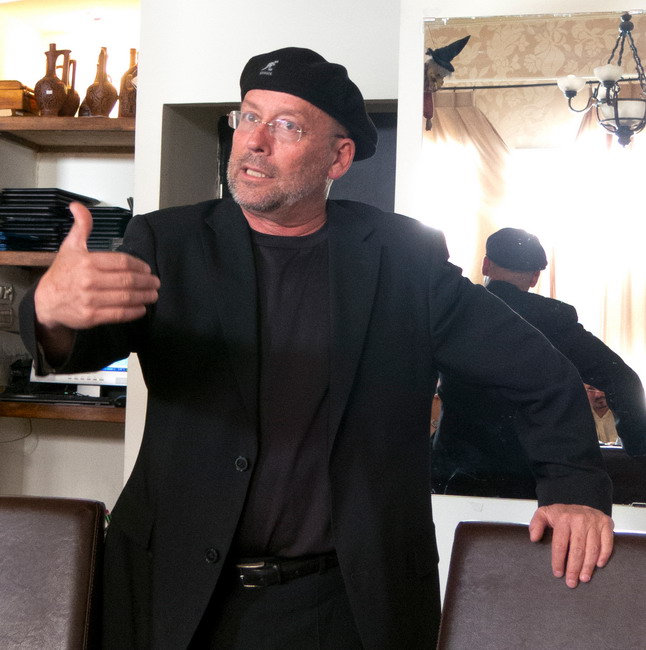



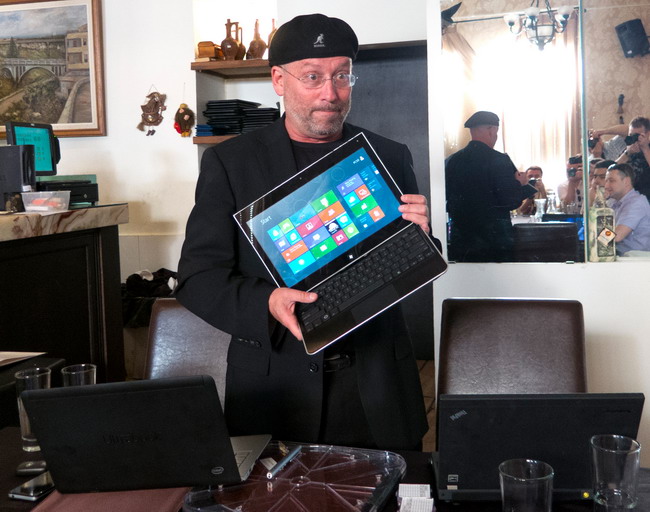



At the end of the speech, Muli showed two prototypes of ultrabooks on the Ivy Bridge. The first outwardly was not much different from the models presented today on the shelves, but worked on Windows 8 and had a touch screen. We can look at it closely and, thanks to the service stickers on the back, look a little inside.


But the second really hooked me. Many acquaintances complain that they now have to take both a tablet computer and a laptop on trips. The first one is very good with its versatility - if you want a movie, see, you want to read the mail, and if you are tired of everything - play for your pleasure. But when it comes to serious work, no trailed keyboard helps - you need a full-fledged computer. Therefore, without a laptop - no way. The prototype demonstrated by Muli combines the best qualities of these devices. At first it seems that you are holding a regular tablet. Lightweight, rather thin, with a great screen. But one easy movement, and the tablet turns ... No, not into elegant shorts, but into a full-fledged ultrabook - with a comfortable keyboard and touchpad. It is not just convenient. This is a delight.
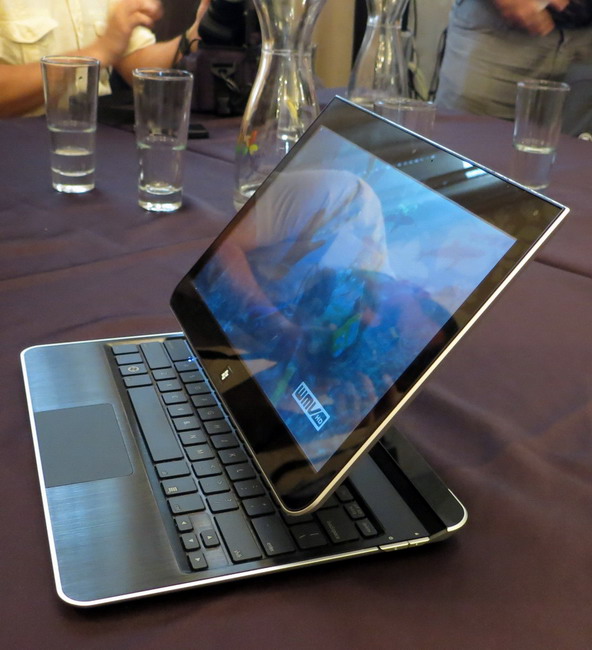
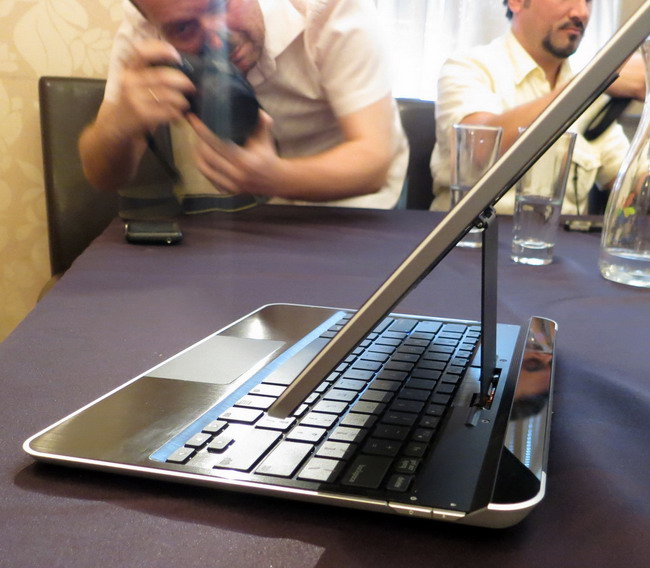
The production technology of Ivy Bridge and the family’s energy efficiency make it possible to mass-produce such combines now, however, according to Muli, their time will come in a couple of years. There are several reasons. First, the device should not just resemble a tablet computer, but be it. In every way. So that the battery kept at least ten hours, and the weight is reasonably convenient, and the applications work normally in the traditional control and touch mode. Secondly, the price should be reasonable, at the level of “just tablets”. The case of the prototype shown is made of titanium - this is the only way to ensure sufficient compactness and strength. This, yes, in combination with other technical tricks, would raise the retail price to 2-3 thousand dollars. As we understand, with such a price tag, it would only be a matter of very niche solutions, while in Intel the Ultrabook platform seems like a massive one. But in a couple of years, technologies will catch up and become cheaper, and then, according to Muli, this form factor will become the main one on the market. And it is quite possible that such solutions will work not only on the Microsoft OS.
I would have talked in more detail about the factory Fab 28, but, unfortunately, I haven’t yet been sent official photos of its entrails, and I practically don’t have my own photos - for reasons of confidentiality, it’s forbidden to take pictures inside.

Therefore, we will probably make another post about it, but for now - a couple more facts about Intel in Israel. The corporation is represented in five cities of the Promised Land, and now has nearly 8,000 employees. For five (!) Years, Intel has been awarded the title of the best employer in Israel - so to speak, on the basis of merit. This is not only a matter of high wages (they are just quite ordinary by the standards of the Israeli IT industry), but also of a rich social package. Employees are really treated very respectfully and carefully, creating conditions not only for work, but also for living outside the offices. Probably, it does not make much sense to list all the pleasant details of a model contract, which are overgrown with new bonuses with each year. Just rejoice for people who are interested and well.

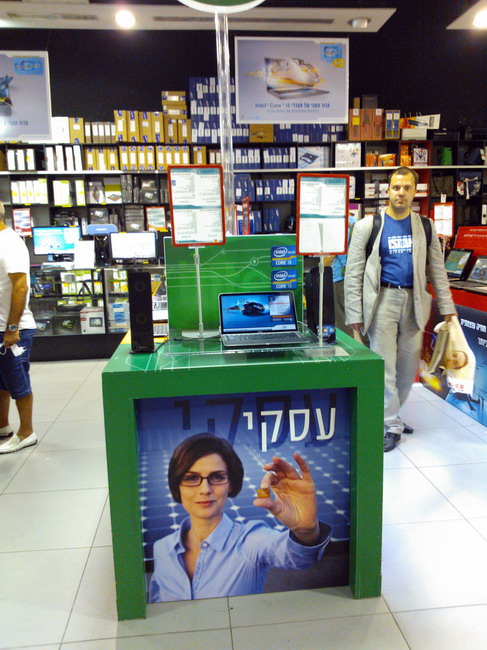
Already leaving Israel, we met quite a few ultrabooks at the David Ben-Gurion airport shop. Inside each of them is an Israeli development - a processor of the Sandy Bridge family. But it will take a little more time, and to replace these elegant "old men" will come new models. What they will be, we will find out no later than June 5, when Computex will start in Taiwan. I will try to quickly share what I saw.

Intel Development Center in Haifa opened in July 1974. Previously, nothing like this was created outside the US, and if it were not for the energy of Dov Froman, the inventor of the EEPROM memory and part-time Israeli, it would be unlikely that a young company at that time would take such a risk. The Middle East is a delicate matter, you know. Suffice to say that the opening was originally scheduled for October 1973, but then suddenly the Doomsday War began, forcing it to postpone everything for more than six months. At the time of launch IDC (Israel Design Center) staff consisted of only five people, and no one pinned on them special hopes. Like, let the guys work, but we'll see. However, the results exceeded all expectations.
')

Processors manufactured at different times on the Fab 28 and manufactured now

The first Ivy Bridge came to light precisely in Kiryat Gat
Does anyone remember which processor the first IBM PC was running on? That's right, on the i8088. It was fully developed in Haifa. Mathematical coprocessors for i386 / 486 (I remind the youth that they significantly increased the speed of operations with a floating point, and in those ancient times they were not built in directly in the CPU) were also born in Haifa and were made on the Fab 8 already built by that time (also the first Intel plant outside the US). Further more. Pentium MMX, Pentium IV, Core 2 Duo, Centrino platform (everything from the processor to the WiFi adapter) - they all come from Israel. True, it is necessary to make an important reservation. Intel - company a) international and b) American. Correspondingly, when my Israeli interlocutors speak about "fully and completely", this means that most of the work was really done in the Holy Land, but intellectual and other capacities were used in other countries, and the decision to start production was taken in the States. Nevertheless, when the project manager is in Haifa, and all the developers, too, it means a lot (for more details on the history of Intel in Israel, I told in the article " Mother of all processors ").
The first generation Core (Nehalem and others) was not invented in Israel, but the second generation (Sandy Bridge) is already yes. 3d Generation Intel Core, according to general manager and president of Intel Israel Muli Eden, was developed half in Israel, half outside. But the first crystals Ivy Bridge, made by 22-nanometer technology, were born on Fab 28, located in Kiryat Gat. I knew that everything would be exactly like that a year and a half ago when I was taken inside the plant and showed how the equipment is being installed. They showed - and immediately imposed a vow of silence, because no one has canceled a commercial secret. And now, being on the Fab 28 again, I saw that the workshop, which was half empty at one time, was densely filled with various smart machines (over a thousand of them were installed), and production is in full swing. Muli Eden says that Ivy Bridge "went" fine, and he is constantly being asked - is it possible to increase production? Alas, the technology, to put it mildly, is not easy, it is impossible to increase the output of crystals by more than 5-10%, and we can only talk about the deployment of new capacities. They are not cheap (25-30 million dollars for one car is not the limit), and even if you place an order for new equipment, you will have to wait for it for at least six months. Plus installation, plus debugging ... And who knows what the demand will be by that time, was it worth it? By the way, Intel usually takes three years to build a new plant (from deciding to launching the first product). It seems to be a bit, given the complexity of the building and equipment. But by the standards of the IT industry, three years is almost an eternity. And Intel is not afraid to regularly look into it.

Speaking about Intel and Israel, one cannot bypass the figure or, if you like, the phenomenon of Muli Eden, already mentioned in this post. He joined Israel Design Center in 1982 and eventually became one of the leading employees. It was he who led the work on the Pentium MMX, and, considering Muli’s powerful sense of humor, I wouldn’t be surprised if the dancing people in white space suits that we saw in advertising were born in his head (by the way, in Intel itself the white suits of employees who have access to clean rooms, called bunny suits). Assessing the effectiveness of Eden, he was invited to work in the States, where our hero was waiting for an impressive career - up to the senior vice president of Intel and general manager of the all PC Client Group. However, with all their sympathy for America, Muli and his family were very sorry for Israel, and they returned home a couple of months ago.
We met with the new head of Intel in Israel in a Tel Aviv restaurant with the absolutely Israeli name Baba Yaga. At first he talked about the third generation Core in general, but the readers of this blog have heard about it, and we will not repeat it. But a few photos taken during his story, yet publish. Muli Eden is deservedly considered one of the best speakers in the industry, and watching him is a great pleasure.








At the end of the speech, Muli showed two prototypes of ultrabooks on the Ivy Bridge. The first outwardly was not much different from the models presented today on the shelves, but worked on Windows 8 and had a touch screen. We can look at it closely and, thanks to the service stickers on the back, look a little inside.


But the second really hooked me. Many acquaintances complain that they now have to take both a tablet computer and a laptop on trips. The first one is very good with its versatility - if you want a movie, see, you want to read the mail, and if you are tired of everything - play for your pleasure. But when it comes to serious work, no trailed keyboard helps - you need a full-fledged computer. Therefore, without a laptop - no way. The prototype demonstrated by Muli combines the best qualities of these devices. At first it seems that you are holding a regular tablet. Lightweight, rather thin, with a great screen. But one easy movement, and the tablet turns ... No, not into elegant shorts, but into a full-fledged ultrabook - with a comfortable keyboard and touchpad. It is not just convenient. This is a delight.


The production technology of Ivy Bridge and the family’s energy efficiency make it possible to mass-produce such combines now, however, according to Muli, their time will come in a couple of years. There are several reasons. First, the device should not just resemble a tablet computer, but be it. In every way. So that the battery kept at least ten hours, and the weight is reasonably convenient, and the applications work normally in the traditional control and touch mode. Secondly, the price should be reasonable, at the level of “just tablets”. The case of the prototype shown is made of titanium - this is the only way to ensure sufficient compactness and strength. This, yes, in combination with other technical tricks, would raise the retail price to 2-3 thousand dollars. As we understand, with such a price tag, it would only be a matter of very niche solutions, while in Intel the Ultrabook platform seems like a massive one. But in a couple of years, technologies will catch up and become cheaper, and then, according to Muli, this form factor will become the main one on the market. And it is quite possible that such solutions will work not only on the Microsoft OS.
I would have talked in more detail about the factory Fab 28, but, unfortunately, I haven’t yet been sent official photos of its entrails, and I practically don’t have my own photos - for reasons of confidentiality, it’s forbidden to take pictures inside.

Therefore, we will probably make another post about it, but for now - a couple more facts about Intel in Israel. The corporation is represented in five cities of the Promised Land, and now has nearly 8,000 employees. For five (!) Years, Intel has been awarded the title of the best employer in Israel - so to speak, on the basis of merit. This is not only a matter of high wages (they are just quite ordinary by the standards of the Israeli IT industry), but also of a rich social package. Employees are really treated very respectfully and carefully, creating conditions not only for work, but also for living outside the offices. Probably, it does not make much sense to list all the pleasant details of a model contract, which are overgrown with new bonuses with each year. Just rejoice for people who are interested and well.


Already leaving Israel, we met quite a few ultrabooks at the David Ben-Gurion airport shop. Inside each of them is an Israeli development - a processor of the Sandy Bridge family. But it will take a little more time, and to replace these elegant "old men" will come new models. What they will be, we will find out no later than June 5, when Computex will start in Taiwan. I will try to quickly share what I saw.
Source: https://habr.com/ru/post/144767/
All Articles